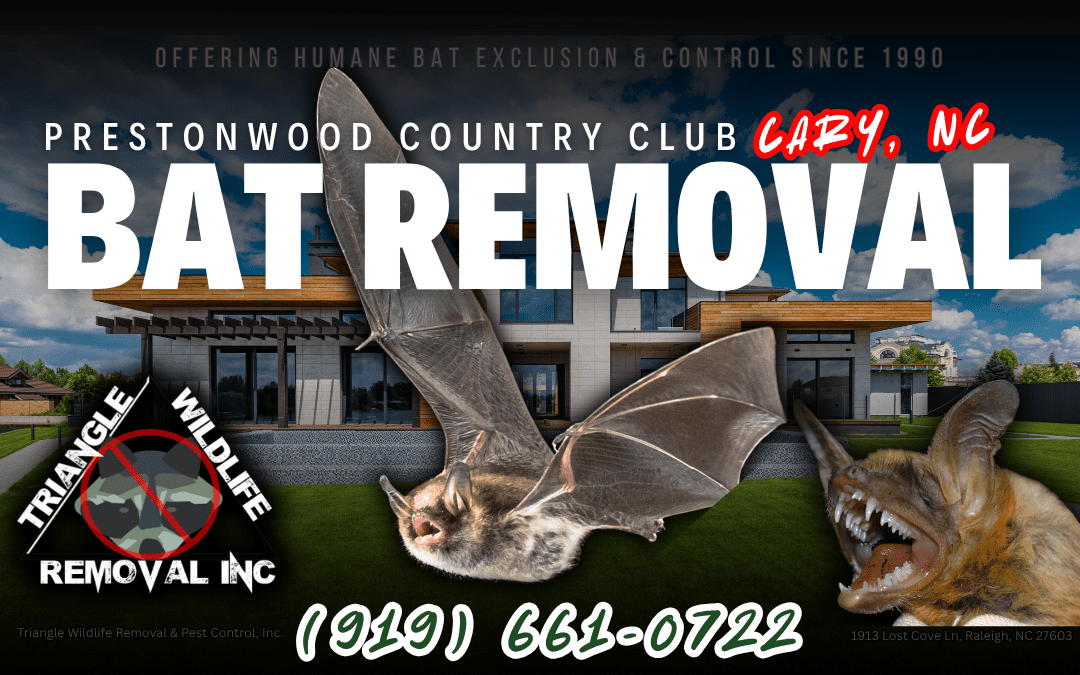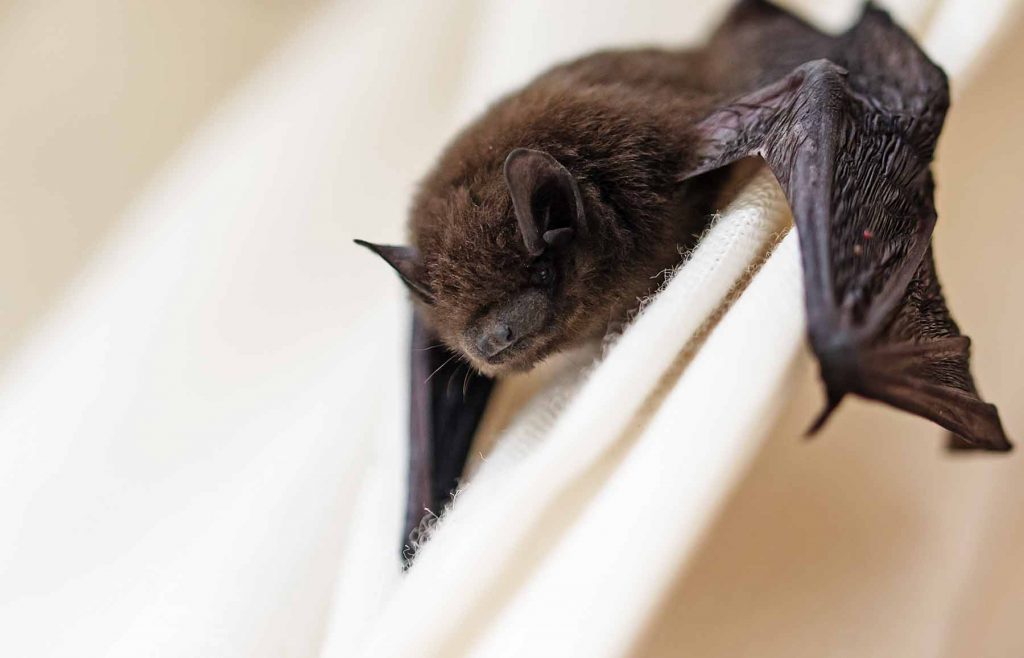Bat Removal Prestonwood Country Club, Cary, NC
We provide effective bat removal services for Prestonwood Country Club in Cary, NC. We specialize in safely and humanely removing bats to keep a comfortable atmosphere for members and staff. Our process includes identifying entry points and using expert methods to relocate bats without harm. Making sure future infestations are prevented is a key part of our approach. Many of our clients are happy with the results. More details on our services and process are available for those interested.
Key Article Highlights
- We specialize in safe and humane bat removal services for Prestonwood Country Club, ensuring minimal stress to the animals.
- Our comprehensive inspection identifies entry points and roosting areas, allowing us to apply effective, tailored bat control strategies.
- We use ethical techniques, including exclusion and live trapping, to prevent future bat infestations while supporting wildlife conservation.
- We provide follow-up inspections to ensure long-term results and help Prestonwood Country Club maintain a comfortable space for members and staff.
- Clients appreciate our expertise and focus on customer satisfaction, giving peace of mind when it comes to bat problems.
Understanding the Bat Problem at Prestonwood Country Club
While the presence of bats may seem harmless, Prestonwood Country Club has faced challenges due to these creatures. Bats are known for their unique behavior, often roosting in hidden areas, which can make them difficult to manage. Their environmental impact is significant, as they help control insect populations. However, when bats invade club facilities, they can cause disturbances. Members and staff may feel uneasy, affecting the club’s atmosphere. It is essential for the country club to address these concerns promptly. Understanding bat behavior is vital for effective removal strategies. By managing the bat problem carefully, the club can maintain a peaceful environment while respecting the role bats play in the ecosystem. Safe bat removal is crucial to ensure the safety of everyone involved and to prevent future issues. Additionally, bat exclusion techniques are essential for preventing re-infestation and ensuring long-term peace.
Health Risks Associated With Bats
Bats can pose several health risks to humans. They may carry diseases that can be transmitted, leading to serious health concerns. Additionally, their presence can trigger allergic reactions and cause damage to structures. Flying squirrels in attics can also contribute to these issues if they are mistaken for bats or coexist in the same environment. It is important to recognize that bat guano can harbor harmful pathogens, increasing the risk of infection.
Disease Transmission Risks
What health risks do bats pose to humans? Bats can carry diseases that may be transmitted to people. Their unique bat physiology allows them to host various pathogens without getting sick. This leads to zoonotic transmission, where diseases jump from animals to humans.
| Disease | Symptoms |
|---|---|
| Rabies | Fever, confusion |
| Histoplasmosis | Cough, fatigue |
| Nipah Virus | Fever, respiratory issues |
| Ebola | Fever, bleeding |
Understanding these risks is vital for those living near bat populations. Taking precautions can help minimize exposure and protect health. Awareness of these diseases helps guarantee safety in shared environments.
Allergic Reactions Potential
Health risks associated with bats extend beyond diseases; allergic reactions can also occur in individuals exposed to these creatures. Those who encounter bats may experience various allergic responses due to bat behavior and their droppings.
- Respiratory Issues: Inhalation of bat droppings can lead to asthma and other breathing problems.
- Skin Reactions: Direct contact with bat urine or feces may result in rashes or irritation.
- Eye Irritation: Exposure to allergens from bats can cause watery or itchy eyes.
While rabies concerns often dominate discussions about bats, it’s important to recognize that allergic reactions pose their own health risks. Awareness and proper removal services can help mitigate these issues effectively.
Structural Damage Concerns
While many people focus on the health risks associated with bats, structural damage can also be a significant concern. Bats often find entry points in buildings, such as gaps in roofs or walls. Once inside, their roosting habits can lead to serious issues. The accumulation of bat droppings, known as guano, can damage insulation and wood. This waste can also attract pests, such as insects, which may worsen the problem. Over time, the structural integrity of a home or building may be compromised. It is important for property owners to address bat entry points quickly. Taking action not only helps maintain a safe environment but also protects the structure from further damage caused by these creatures.
Signs of a Bat Infestation
Signs of a bat infestation can often be detected by unusual noises at night. Homeowners may hear fluttering or chirping sounds as bats become active. Additionally, a foul odor may be present, indicating the presence of bat droppings or urine. Bat activity can sometimes be observed near entry points or roosting sites around the home. Bats are known to seek out shelter in attics, which can further contribute to these signs.
Nocturnal Activity Noises
Nocturnal activity noises can be a clear indication of a bat infestation in a home. These sounds often occur at night, when bats are active, hunting for food. Their diet mainly consists of insects, making them vital nocturnal predators.
Here are three common noises to listen for:
- Chirping or squeaking: These sounds may indicate communication between bats.
- Fluttering: The sound of wings flapping can be heard as bats move in and out of roosting areas.
- Scratching: Noises coming from walls or attics might suggest bats are nesting within the structure.
If these sounds are noticed, it is essential to seek professional help to address the potential bat infestation effectively.
Foul Odor Presence
A foul odor can be a strong indicator of a bat infestation in a home. This smell often comes from bat droppings and urine, which can accumulate in hidden areas. Homeowners may notice a musty or ammonia-like scent. Identifying this odor early is crucial to effective bat exclusion.
| Odor Type | Possible Source |
|---|---|
| Musty | Accumulated droppings |
| Ammonia-like | Bat urine |
| Decaying material | Dying bats or food sources |
If a foul odor is detected, it is essential to seek help. Professionals may utilize ultrasonic deterrents to assist in removal, ensuring homes remain safe and odor-free.
The Importance of Professional Bat Removal
While many homeowners may attempt to handle bat infestations on their own, the significance of professional bat removal cannot be overstated. Bats play a vital role in maintaining fauna diversity, but they can also disrupt a bat habitat when they invade homes. Professionals provide expertise that guarantees safety and effectiveness. They also ensure ethical wildlife removal, which minimizes stress and injury to the bats and the surrounding environment. Professionals use humane methods to remove bats without harming them or residents. They can seal entry points and offer advice on keeping bats away in the future. Choosing professional services helps protect both the home and the natural environment, ensuring a balanced ecosystem.
Triangle Wildlife Removal’s Bat Removal Process
Triangle Wildlife Removal employs a systematic approach to bat removal that prioritizes safety and efficiency. Their process begins with a thorough inspection of the property to locate potential entry points. Understanding bat ecology is essential, as it helps in identifying where bats roost. Once the areas are found, the team plans a safe removal strategy that minimizes stress for the bats while ensuring the safety of the residents. Triangle Wildlife Removal focuses on wildlife conservation, promoting the importance of bats in the ecosystem. By using humane techniques, they aim to relocate bats without harm. This careful method not only protects the bats but also allows homeowners to regain their space peacefully, fostering a balance between human habitation and wildlife.
Safe and Humane Removal Techniques
Using safe and humane removal techniques is essential for effective bat control. These methods guarantee the bats are not harmed while addressing the problem. The following techniques are commonly used:
- Exclusion: Sealing entry points to prevent bats from returning. This is key to stopping bat guano accumulation.
- Trapping: Using live traps that allow bats to be captured without injury. This respects their natural behavior and wing span.
- Eviction: Encouraging bats to leave their roosting spots naturally at dusk, which is less stressful for the animals.
Preventing Future Bat Infestations
After successfully removing bats using safe and humane techniques, it is important to focus on preventing future infestations. Bat exclusion is vital for keeping these creatures from returning. This involves sealing entry points, such as cracks and gaps in walls or roofs, where bats might enter. Regular inspections can help identify potential vulnerabilities in the structure. Additionally, guano cleanup is essential, as bat droppings can attract more bats and pose health risks. By maintaining cleanliness and ensuring that areas are free from guano, property owners can greatly reduce the chances of a new infestation. Taking these proactive steps enables individuals to enjoy their space without the worry of bats returning.
Why Choose Triangle Wildlife Removal
Choosing a professional service for wildlife removal can substantially impact the effectiveness of bat control efforts. Triangle Wildlife Removal stands out for its commitment to both efficiency and ethical practices. Their services not only focus on bat removal but also respect the cultural significance of bats and promote bat conservation.
- Expertise: Their trained professionals understand bat behavior and ecology.
- Humane Methods: They use humane techniques that protect these important creatures.
- Long-Term Solutions: Their strategies aim to prevent future infestations while ensuring bats remain safe.
Testimonials From Satisfied Clients in Cary, NC
Clients in Preston Country Club in Cary, NC, have shared positive experiences with Triangle Wildlife Removal’s bat removal services. Many homeowners appreciated the team’s knowledge about different bat species. They felt reassured knowing that the experts understood the specific needs of each type. Clients noted how the removal tools used were safe and effective. This provided peace of mind during the process. Satisfied customers often mentioned how quickly the team addressed their bat problems, allowing them to reclaim their homes. They expressed gratitude for the thorough inspections and follow-up services. Overall, clients felt empowered to enjoy their living spaces again, free from the worry of bats. Triangle Wildlife Removal’s commitment to client satisfaction shines through in these testimonials.

